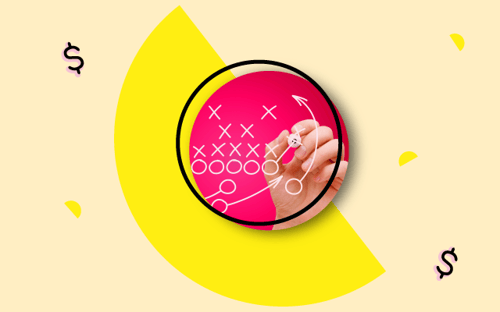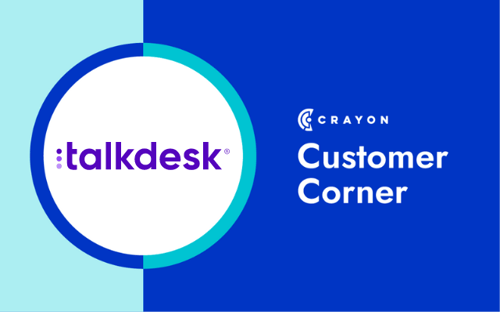Alec Baldwin wouldn’t be the patron saint of closing deals if, in perhaps the most cliche sales reference in cinematic history, he’d said “always be… enabling.”
Sellers are hired to sell.
It’s the job of sales enablement, then, to put reps in position to win. To educate through training and arm them with content that helps win deals.
In this post, we’ll define exactly what sales enablement is and why you need to embrace it, before answering some of the most common questions we hear on the subject.
What Is sales enablement?
In plain English, it’s helping sales reps succeed.
Sales Enablement Definition
Sales enablement refers to the set of processes and resources you provide to your sales team to help them close more deals more efficiently.
Armed with the right data and tools at the right time, your salespeople are empowered to drive more revenue.
But what does this actually look like?
There’s no one-size-fits-all answer. Sometimes sales enablement means creating case studies and talk tracks and battlecards. Other times, it’s providing competitive intelligence or deep product training. In either case, it’s heavily cross-functional and becomes exponentially more impactful when execution is supported by technology and automation.
Your 8 Most Pressing Sales Enablement Questions Answered
1. What is the objective of sales enablement?
While the objectives of sales enablement may vary business-to-business, there are always two core tenets.
- Sales enablement should bolster performance: Simply put, sales enablement should help reps close more deals more efficiently. This is your north star.
- And it should do so at scale: This is no time for hand-to-hand combat. Helping individual reps with one-off requests is great, altruistic team spirit and all. But systematization is the secret to efficient success. I’m talkin’ easily-accessible collateral. Actionable training. Simplified onboarding. You get the gist.
Regardless of the means (be it battlecard or talk track or training or whatever else you’re cooking up), you should be spending precious hours on sales enablement to help reps bring in more revenue faster, not out of some misguided sense of altruism (though that’s nice, too).
2. What is B2B sales enablement?
B2B sales enablement refers to the process of working with sales reps to figure out (1) what’s keeping them from winning deals and (2) what can be done to minimize or eliminate those roadblocks.
Roadblocks that may keep a given sales rep from winning deals include
- Lack of experience running discovery calls and demos
- Weak content that fails to pique the interest of prospective buyers
- Outdated competitive intelligence
Steps you can take to help a frustrated sales rep overcome these roadblocks include:
- Offering discovery call and demo training sessions
- Regularly refreshing content to ensure alignment with buyers’ pain points
- Delivering real-time competitive intelligence in the form of dynamic battlecards
Because B2B purchases are rarely made on impulse (there’s a difference between buying a competitive intelligence tool and, say, a cinnamon bun slathered with frosting at the mall), sellers often engage prospects in prolonged sales cycles. Arming them with the knowledge and tools they need to engage prospects throughout the buying process is critical to their success. By doing so, B2B sales enablement ensures as many reps hit and exceed quota as possible.
3. What are sales enablement platforms?
No sense reinventing the wheel here. To quote the wonderful people over at G2, arbiters of niche definition in the SaaS world:
To qualify for inclusion in the Sales Enablement category, a product must:
- Act as a repository of marketing content to be used by sales representatives
- Track prospect and customer engagement on content and sales pitches
- Allow users to upload a variety of collateral or build content directly within the tool
G2 lists more than 150 businesses in its Sales Enablement grid:
As you can see, this is in an extremely broad category, and for good reason: Sales enablement is a vast, multifaceted function. As such, developing a top-notch program often requires multiple platforms to unlock efficiency at scale.
4. What is sales enablement training?
Let’s get something out of the way: Sales Enablement ≠ Sales Training.
Yes, they sound interchangeable.
They even kinda look the same.
But sales enablement and sales training refer to two totally different parts of your organization.
Sales training is used to give reps the skills and strategies they need to close as many deals as possible. It teaches reps everything they need to do their job. Sales enablement provides reps with content, and resources required to help them close more deals more efficiently.
At the end of the day, sales enablement and training exist to create an improved sales process.
5. What is strategic enablement?
Strategic enablement is a specific sales enablement blueprint.
Coined by sales enablement platform Highspot, the strategic enablement framework boils down to defining and systematizing winning behavior.
In many sales organizations, there are a small handful of reps who absolutely crush it, and significantly more who struggle. There’s little to no middle class of sellers, so to speak. Those who are struggling are cost centers; they consume sales enablement resources but don’t close deals. This is bad for personal morale and for business.
Here’s how it works.
First, you identify the habits of top-performers. Then you operationalize those habits, teaching new and lower-performing reps how to adopt those winning techniques and lifting org-wide performance in the process.
The goal of strategic enablement is to turn a “haves and have nots” system into something resembling a bell curve.
6. Where does sales enablement live?
Well, if you’re reading this post… in your heart?
Though to avoid creating a bottleneck, let’s go with a resoundingly squishy “it depends.” Sales enablement is inherently cross-functional. Regardless of where it lives, team members from across an organization contribute to it, from marketing to operations to, yup, you guessed it, sales.
Now, if the question you’re asking is “where should sales enablement live,” that’s a different story.
We say the answer’s marketing.
Rarely is sales charged with creating collateral; they’re charged with using it.
If, as we defined it earlier, sales enablement is the process of empowering your sales reps with the tools, resources, and competitive intelligence they need to win deals, it doesn’t make much sense for the function to live within. It isn’t called self enablement.
7. What are sales enablement materials?
Sales enablement materials are created in order to help sales reps succeed in turning prospects into customers. It’s educational in nature, and may include:
- Battlecards: Battlecards arm your sales reps with quick, at-a-glance information as to how your product compares with alternatives in the market. You should have one battlecard dedicated to each of your competitors, and each one should include your relative strengths, your respective pricing structures, up-to-date field intelligence, and so on.
- Pricing calculators: Depending on how you charge your customers, the price tag on one contract could be many times greater than the price tag on another. When it comes to B2B competitive analysis, pricing calculators — which often live in spreadsheets — can make life infinitely easier for your sales reps. This is crucial, as price is often a major concern for prospects evaluating solutions in a crowded market.
- Pitch decks: Whenever a sales rep gets the opportunity to chat with a prospect, chances are they’re going to prepare some slides — this is one of the most common ways in which solutions are introduced to potential users and buyers. Pitch decks are useful even after the initial presentation, as prospects can circulate them to their coworkers and/or managers in order to (hopefully) generate interest in a follow-up call.
- Case studies: If you’re thinking about buying a product, almost nothing is more persuasive than a real-world example of someone using that product and thriving as a result. The case study is one of the most powerful types of sales enablement content as it allows prospects to visualize themselves as your customers. If your product addresses a pain point that people actually care about, this visualization exercise should often work in your favor.
- Thought leadership content: A great way for a sales rep to win the trust of a prospect is to demonstrate the authority with which your company discusses certain topics. Thought leadership content — which can come in the form of blog posts, videos, podcast episodes, ebooks, industry reports, etc. — is a signal to prospective customers that your solution is the solution. If you were evaluating a product, wouldn’t it be comforting to know that the people selling it sincerely know what they’re talking about?
8. How do you measure the effectiveness of sales enablement?
We can break sales enablement success into two buckets: quantitative and qualitative.
Quantitative: Competitive win rate
Competitive win rate is the rate at which you win deals over them. In other words, your competitive win rate tells you how often your sales reps succeed when going head-to-head with a specific competitor in the sales process.
CWR = # deals won over Competitor A / # deals involving Competitor A
Now, let’s say that three months ago you rolled out a battlecard focused on Competitor A. How, if at all, has your competitive win rate changed since then? If it’s improved significantly, that’s evidence of effective sales enablement content. If it hasn’t changed — or if it’s worsened — then it’s safe to say that you have work to do.
Qualitative: Talking to your team
Although quantitative data is undeniably useful, you shouldn’t overlook the power of simply talking to your sales reps about what is and isn’t working in terms of sales enablement. You can get a lot of insight from questions as simple as:
- How have your demos been going since our last training sessions?
- Which competitor do you feel most prepared to discuss when chatting with a prospect?
- Do you have a go-to piece of content when you’re trying to nurture a prospect?
Of course, you can quantify the responses you get to these questions.There’s nothing wrong with creating a quick, simple survey and asking your reps to complete it whenever possible. Our point with this last tip is not to discourage quantitative data, but rather to encourage candid conversations with the people you’re trying to help.
Empower Your Sales Team With Crayon
Sales enablement starts with powerful data and ends with on-demand access. It ensures reps are educated and empowered to close deals without constantly leaning on collateral, but makes content readily available when they need it most.
Arm your team with the right intel at the right time with Crayon’s award-winning sales enablement platform: Get a demo today!

Related Blog Posts
Popular Posts
-
 The 8 Free Market Research Tools and Resources You Need to Know
The 8 Free Market Research Tools and Resources You Need to Know
-
 How to Measure Product Launch Success: 12 KPIs You Should Be Tracking
How to Measure Product Launch Success: 12 KPIs You Should Be Tracking
-
 24 Questions to Consider for Your Next SWOT Analysis
24 Questions to Consider for Your Next SWOT Analysis
-
 How to Create a Competitive Matrix (Step-by-Step Guide With Examples + Free Templates)
How to Create a Competitive Matrix (Step-by-Step Guide With Examples + Free Templates)
-
 6 Competitive Advantage Examples From the Real World
6 Competitive Advantage Examples From the Real World





